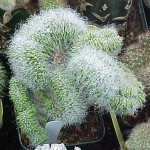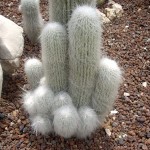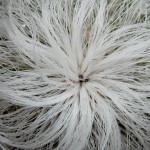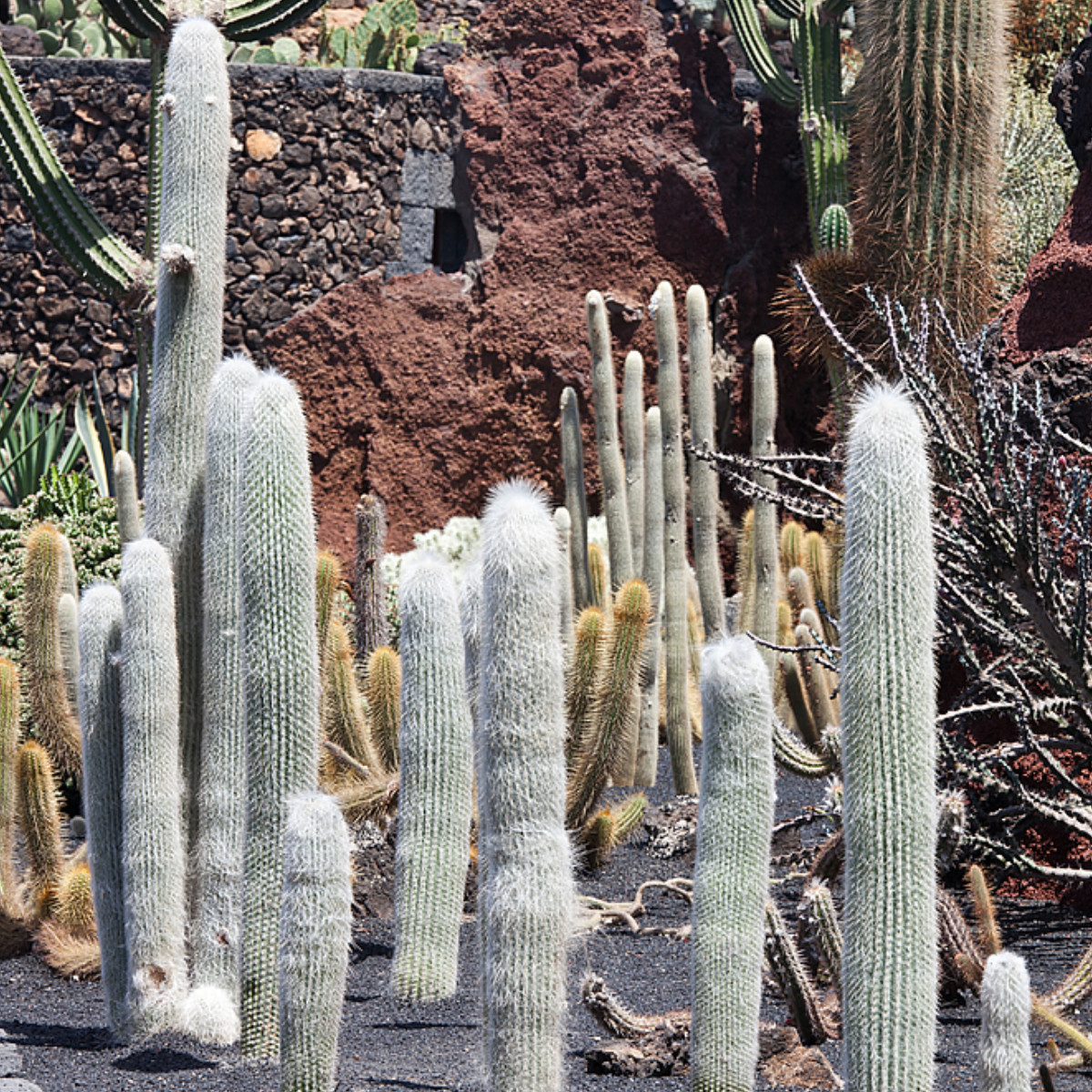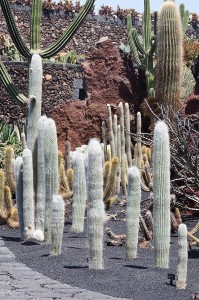Family: Cactaceae
Synonymous: Cactus bradypus
Cactus senilis
Cephalophorus senilis
Cereus senilis
Echinocactus staplesiae
Pilocereus senilis
Distribution and habitat: Cephalocereus senilis is a species of cactus native to Guanajuato and Hidalgo in eastern Mexico. It is threatened in the wild, but widespread propagation and popularity in cultivation have reduced the demand on wild populations. The species is one of the dominant elements of the xerophile scrub where it grows and it is restricted to calcareous canyons within xerophile vegetation.
Description: Cephalocereus senilis is a tall, columnar species with clusters of stem. The individual stems are usually unbranched, being unable to withstand the weight of a side branches adequately. The stem is divided lengthwise into 20 to 30 shallow ribs, along the edges of which run rows of closely set areoles. Arising from the areoles are not only the hairs (which can grow up to 12cm (5 inch) long) but from one to five yellow spines per areole. The most striking feature is the shaggy coat of long, white hairs suggestive of unkempt hair on an old man. The coat is a particularly striking silvery white on the young cactus; as the plant ages the stem begins to lose its covering. The hairs are modified spines and they make many a plant appear almost snow-white; they serve to protect the plant from frost and sun.
In the wild Cephalocereus senilis can grow up to 12m tall (when 200 years old), but as a slow growing indoor plant it is unlikely to grow taller than 30cm (12 inch) or to require a pot larger than 15cm (6 inch). Since the plant cannot reach maturity indoors, it will not flower.
Cephalocereus senilis is not expected to flower until 10-20 years old. The flowers are produced from the cephalium, along one side of the stem near the apex. Thelateral cephalium does not form until the plant is 6m (20 feet) tall as this cacti reaches its maturity. The flowers are nocturnal, trumpet-shaped, about 8cm (3 inch) long and 7cm (2.75 inch) in diameter and whitish-yellow coloured. Cephalocereus senilis will flower in summer season and flowers are followed by pinkish-red fruit, 2-3cm (0.8-1 inch) long covered with yellowish hair.
Houseplant care: Cephalocereus senilis is commonly used as a potted plant grown indoors. Avoid stroking the plant, since the hair conceals 2cm (0.8 inch) long spines.
In time the white hairs of Cephalocereus senilis tend to turn brownish. Some of this discoloration is due to dirt and can be removed by shampooing with a warm detergent solution and rising in clean water. To avoid soaking the potting mixture with detergent, cover it up while washing the plant.
Much of darkening the hair, however, is due to age and must be accepted.
Light: In the wild these cacti are protected from intense sunlight by their hair, thus, the greater the intensity of the light the longer and thicker are the hairs. If possible place these plants at a window where they are likely to be exposed to constant sunlight.
Temperature: In spring and summer normal room temperatures are suitable for an actively growing Cephalocereus senilis, between 18-29C (65-85F). In winter the plant should be encouraged to rest at a temperature below 16C (61F), though always above 5C(41F). High winter temperatures coupled with the insufficient light of short winter days will cause the plant to grow unnaturally elongated stems.
Watering: During the active growth period water these cacti moderately, enough to make the potting mixture moist throughout, but allowing the top centimetre (0.4 inch) or so to dry out before watering again.
During the rest period water only enough to keep the mixture from drying out completely. Too much water during the short day months encourages unnatural growth and can cause rotting of the base of the stem.
Feeding: At the start of the growth period apply a dressing of slow-release fertiliser and stir it into the surface soil in the pot. Avoid splashing the hairs with fertiliser.
Potting and repotting: Either soil based or peat based mixture can be used with addition of one-third portion of coarse sand. These plants can usually be grown in 8cm (3 inch) pots until they are 7-10cm (2.75-4 inch) tall. Examine them each spring, however, to see if the roots fill the pots.
When necessary, move the plants into pots one size larger. If there is still room for roots to grow, replace plants in their original pots, which have been cleaned. Add some fresh potting mixture to the pot if necessary.
Gardening: Cephalocereus senilis is a very popular cactus in warm climate desert gardening, grown for its woolly appearance. It is great for inexperienced gardeners and those that like low maintenance gardens, but this cacti is a frost tender. In colder climates, it is recommended to be keep in a container that can be taken outside for the summer and easily moved indoors for the winter.
It is a very drought and heat tolerant. These facts are making it a stunning xeric landscape plant where it can reach its largest, most impressive size.
This cacti has sharp thorns. Plant them away from play areas and pathways. Wear gloves and protective eyewear when handling cactus plants.
Location: Cephalocereus senilis needs lots of bright sunlight to encourages growth of the hair. Place it in full sun in areas with minimum temperature of 13C (55F). It prefers some afternoon shade in the low deserts.
Soil: Cephalocereus senilis grows in rocky or loose soil which is a fast-draining soil. When planting this cacti amend this soil with some limestone chips for best results.
Irrigation: Cephalocereus senilis requires little to moderate water in summer, almost none in winter. It will grow without any watering other than natural rainfall. It is very rot prone particularly when young, reason why this cacti needs good drainage.
Fertilising: Supplemental fertiliser will speed growth of garden cacti. Fertilise Cephalocereus senilis once in spring using slow-release fertiliser. Incorporate the fertiliser in soil. Water the cactus when fertilise if the soil is dry.
Propagation: Cephalocereus senilis can be propagated only from seed.
Problems:Cephalocereus Senilis is highly-prone to rot from over-watering.
The shaggy hair provide a hiding place for such pest as mealy bugs and spider mites.
Treatment: Insecticides work fine to control these insects.
Sudden wilting and pale green discolouration indicate a fungal infection (phytophthora).
Treatment: Remove infected plants. Prevent this fungal infection by improving drainage and avoid over-fertilisation.
Recommended varieties:
Cephalocereus senilis f. cristata is a mutated form of Cephalocereus senilis where the growing point (apical meristem) of the plant has forms along a line rather than a single point resulting in a fan shape.
Facts: The most common use for Cephalocereus senilis hair is in the making of wool-like sweaters in southern Mexico, and the hair is generally a cheap alternative to cotton in commercial sweater production due to its natural coloring and fluffiness.
Uses and display: Cephalocereus senilis are grown for their hairy appearance making it a strange appearance in cacti collections as a potted specimen and a stunning featureas an old giant cacti in xeric gardens.
SUMMARY:
CHARACTERISTICS:
Shape - columnar
Flowering time - nocturnal
Flowering period - summer
PROPER CARE:
Watering in rest period -sparingly
Watering in active growth period -moderately
Light indoors - direct
Light outdoors - direct sunlight
Compost -standard cactus compost
Temperature in rest period - min 7C max 18C (45-64F)
Temperature in active growth period - min 16C max 24C (61-75F)
Outdoors size: 15m (50 feet) tall, 40cm (16 inch) in diameter
Indoors: 30cm (12 inch) tall
Hardiness zone: 9b-11
